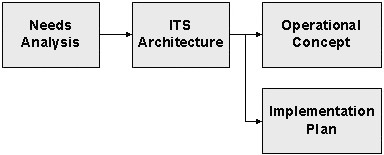|
The process undertaken for the development of the four Regional ITS Architectures for
Massachusetts is illustrated in the following figure:

The first step of this process was the Needs Analysis, which identifies the ITS-related
projects and needs of the operating and planning agencies in the region. This analysis
served as the basis for the development of the functional requirements of the ITS
Architecture and its component systems, developed in the following step. This approach
ensured that the systems and technologies recommended for implementation, as well as the
architecture that provides a framework for these systems, were consistent with the needs
and goals of the region. Documentation from the region, including Regional Transportation
Plans (RTPs) and Transportation Improvement Programs (TIPs), was reviewed as part of the
needs analysis. Further information was obtained at a meeting of the Guidance Committee
and through follow-up meetings with individual agencies.
The next step in the process was the development of the ITS Architecture, which defines the
existing and planned component systems and the interfaces among them. As with the needs
analysis, stakeholder involvement was critical to this step of the process. An initial
draft of the architecture was developed from an inventory of ITS elements identified in the
needs analysis and from stakeholder input at an architecture development workshop.
Refinements to the architecture were made following stakeholder review, including a series
of follow-up review meetings with various groups of stakeholders. Final refinements to the
architecture were made once the architecture process was completed, allowing the
architecture to reflect all of the comments received.
The next two steps resulted in documents derived directly from the ITS architecture. The
first was the development of the Operational Concept, which addresses the institutional
relationships that must be established in order to address the interagency interfaces
defined in the architecture. The purpose of the Operational Concept is to define the roles
and responsibilities of the stakeholders in the operation of the component systems of the
architecture. The Operational Concept details requirements for each of the interagency
interfaces in the architecture. These requirements address the information to be exchanged
and the roles of the interfacing agencies. The Operational Concept also addresses the need
for operational agreements among agencies that share interfaces.
The final piece of the architecture development process was the development of the
Implementation Plan, which provides a strategy for achieving the integrated transportation
system envisioned by the architecture. The Implementation Plan addresses the planned
components of the architecture, identifying a series of initiatives that can be undertaken
to implement these components. Also included in this step was the development of a plan
for maintaining the architecture and ensuring consistency between the architecture and
projects with ITS components. |